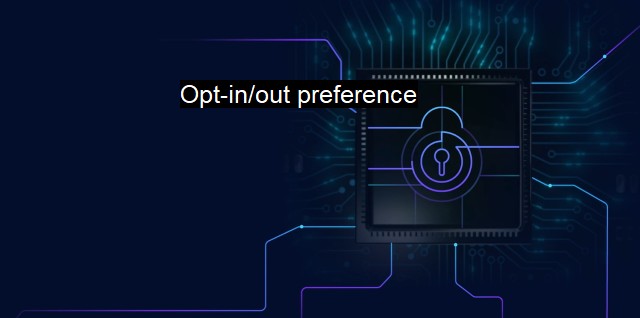What is Opt-in/out preference?
The Role of Opt-in/Out Preferences in Cybersecurity: Giving Users Control Over their Digital Safety
In the realm of cybersecurity and antivirus systems, "Opt-in_out preference" refers to an essential modus operandi related to how users express their consent or non-consent towards a particular service. This method primarily involves users actively choosing whether to engage or disengage from certain activities, communications, or services.The buzzword first emerged specifically referring to marketing scenarios, and has since been used in a broader context, including cybersecurity. Opt-in_out preferences play a critical role in protecting users' rights, their privacy, and contributes to securing and regulating online behavior and activities. This, in combination with antivirus systems and advanced cybersecurity measures, creates a safer, more controlled online environment.
In an opt-in process, users explicitly express their willingness to partake in a certain activity or receive a service. This could be in the form of subscribing to newsletters, joining online forums, activating an account on a platform, or even accepting cookies from websites. Many antivirus software utilize this opt-in feature by asking users for permission to monitor and analyze their system's activities.
To illustrate, once a user installs an antivirus software, they may be asked whether they want specific features activated, such as real-time protection or sending regular system reports. If they chose to not opt-in, these features wouldn’t be activated. This way, the concept of opt-in gives users control over their systems and the software they interact with, thereby promoting privacy and personal liberties.
On the other hand, an opt-out process means the user is automatically enrolled in a service or activity and they must actively choose to disengage themselves. One common opt-out scenario is software updates. Certain software applications automatically update once a new version is available. If the user doesn't wish to receive the update, they have to manually change their preferences, essentially opting out of the automatic update setting.
While often considered less considerate than an opt-in process because it assumes consent by default, opt-out often operates in areas where automatic engagement would generally enhance security or improve user experience. For instance, antivirus programs usually engage automatic updating to ensure optimal defenses against the latest-armamentarium of viruses, malware, and other harmful entities.
For both opt-in and opt-out preferences, the transparency of policies and easy to understand settings are crucial. Operations that affect system performance, collect user data, or subscribe users to constant updates and communications must always clarify these activities to customers clearly. If people understand how their systems are protected and their online behaviors monitored, they are more likely to trust the services, enabling a more secure or effective relationship between the user and cybersecurity operators.
Also, businesses and organizations must respect the users' preferences and adhere strictly to their opt-in or opt-out selections. Non-compliance could result in distrust, degradation of user experience, and even legal actions in scenarios where data handling and privacy regulations are violated.
"Opt-in_out preference" plays a vital role not just in emails and subscriptions, but within the node of cybersecurity and antivirus realities. The procedure helps enhance security measures and enriches user experience by prioritizing user preferences and data privacy. Businesses that engage their customers through this can avoid disrupting non-consenting users, gain the trust of involved participants, and remain well within the guidelines of existing digital and cybersecurity laws.

Opt-in/out preference FAQs
What is opt-in/out preference in the context of cybersecurity and antivirus?
Opt-in/out preference refers to the ability of users to choose whether they want to receive or decline certain types of communications or software updates from cybersecurity and antivirus companies. This can include receiving alerts about potential threats, updates to software, or promotional materials.How do I manage my opt-in/out preferences for cybersecurity and antivirus communications?
Most cybersecurity and antivirus companies provide options for managing your opt-in/out preferences within your account settings. You can usually customize which types of communications you receive and how often you receive them.What are the benefits of managing my opt-in/out preferences for cybersecurity and antivirus communications?
Managing your opt-in/out preferences can help you stay informed about potential threats and keep your antivirus software up-to-date, while also reducing the amount of unwanted communications you receive. It also allows you to tailor your experience to your preferences and needs.Can I opt-out of receiving all cybersecurity and antivirus communications?
While it is possible to opt-out of most cybersecurity and antivirus communications, it is generally not recommended. Staying informed about potential threats and keeping your antivirus software up-to-date is important for maintaining the security of your devices and personal information. Consider customizing your preferences rather than opting out entirely.| | A | | | B | | | C | | | D | | | E | | | F | | | G | | | H | | | I | | | J | | | K | | | L | | | M | |
| | N | | | O | | | P | | | Q | | | R | | | S | | | T | | | U | | | V | | | W | | | X | | | Y | | | Z | |
| | 1 | | | 2 | | | 3 | | | 4 | | | 7 | | | 8 | | |||||||